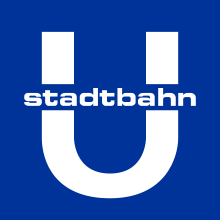Trams in Munich
 | |
| Overview | |
|---|---|
| Locale | Munich, Bavaria, Germany |
| Transit type | Tram |
| Number of lines |
1952: 21 1964: 21 1972: 18 + 3 Olympic special routes 1984: 11 1996: 9 2010: 11 2011: 11 from 2012: 13[1] |
| Number of stations | 165[2] |
| Daily ridership | 284,900 (2012) |
| Annual ridership | 104 million (2012)[2] |
| Operation | |
| Began operation |
1876 (horsecar)[2] 1895 (electric trams)[2] |
| Operator(s) | Münchner Verkehrsgesellschaft |
| Number of vehicles | 106[2] |
| Technical | |
| System length |
1952: 120 km (75 mi) 1964: 135 km (84 mi) 1972: 120 km (75 mi) 1984: 83 km (52 mi) 1996: 68 km (42 mi) 2010: 75 km (47 mi) 2011: 80 km (50 mi) from 2016: 83 km (52 mi)[1] |
| Track gauge | 1,435 mm (4 ft 8 1⁄2 in) |
| Electrification | 750 Volts |
| Average speed | 19.3 km/h (12.0 mph)[2] |

The Munich tramway is the tramway network for the city of Munich in Germany. Today it is operated by the municipally owned Münchner Verkehrsgesellschaft (the Munich Transport Company, or MVG) and is known officially and colloquially as the Tram. Previous operators have included Société Anonyme des Tramways de Munich, the Münchner Trambahn-Aktiengesellschaft, the Städtische Straßenbahnen and the Straßenbahn München.
The tram network interconnects with the MVG's bus network, the Munich U-Bahn and the Munich S-Bahn, all of which use a common tariff as part of the Münchner Verkehrs- und Tarifverbund (Munich Transport and Tariff Association, or MVV) transit area.
As of 2012, the daytime tram network comprises 13 lines[2][3] and is 79 kilometres (49 mi) long with 165 stops.[2] There is also a night tram service with four routes.[2] The network is operated by 106 trams (as of 2012),[2] and transported 98 million people in 2010[4] and 104 million people in 2012.[2]
History
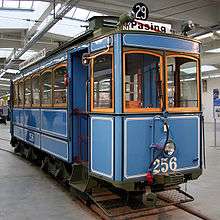
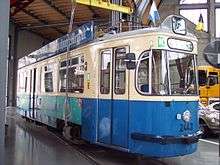
The tramway started in 1876, with a horsecar service.[2] The first tramways extended from Karlsplatz (Stachus), which remains one of central nodes of Munich's tram network. Two years later, the Société Anonyme des Tramways de Munich was founded. In 1882, the Münchner Trambahn-Aktiengesellschaft (MTAG) was founded.[2][5]
Electric trams were introduced in 1895,[2] and in 1900, the last horsecar was taken out of service.[2] In 1907, MTAG was taken over by the city, and changed its name to Städtische Straßenbahnen. In 1919, the municipal agency Münchner Straßenbahnen was established. After World War II ended in 1945, only twenty tram lines remained; of 444 trams, only 168 were in operational condition. In 1956, the first new tram line after the war was opened.[2]
The 1972 Munich Olympic Games presaged a major expansion of public transport in the city. In 1965, construction of the Munich U-Bahn, the city's rapid transit system, was started. It opened in 1971, the same year as the transit authority MVV was founded. In 1972 a new S-Bahn network opened that, like the U-Bahn, was carried in new tunnels under the city centre. As these networks grew, they seemed to threaten the tram network, with extensive line closures in favour of the new modes.[5]
Such closures continued into the 1990s, but in 1991 the city council passed a plan to upgrade and modernize the tramway, as the trams were seen to be a better fit to expected passenger flows on many routes. Three years later, Class R2 low-floor trams were introduced, along with a night network. These were followed, in 1999, by the larger class R3 trams. In 2001, the voltage on which the trams operate was increased from 600 to 750 V. The following year the MVG was formed.[2][5]
In 2009 the brand new route 23 was opened.[2] This route acts as a feeder route for U-Bahn lines U3 and U6, to which it connects in an elaborate terminus above Münchner Freiheit U-Bahn station. The line has no interchanges with other tram routes, but is linked to the rest of the tram network by a connecting track that carries no public service.[5] At the same time,February 2009, class S trams, built to the Variotram design, were introduced.
In December 2011 an extension was opened from the previous Effnerplatz terminus to St. Emmeram.[2] The extension was 4.3 kilometres (2.7 mi) long and added seven new tram stops to the network. Tram route 16 was extended to serve St. Emmeram, with knock-on effects on routes 17, 18 and 27.[5][6]
In December 2012 new routes 22 and 28 were opened.[7]
In December 2013, the extension of route 19, from its previous terminus at Pasing-Marienplatz to München-Pasing railway station, was opened in order to enable better interchange with S-Bahn and long-distance train services.[8]
In December 2016, route 25 was extended to the east of the city, from Max Weber Platz to Berg am Laim S-Bahn station. The extension comprises 2.8 kilometres (1.7 mi) of segregated alignment with seven new stops, and a journey time of approximately eight minutes. The area served is undergoing redevelopment.[9]
Operation
Vehicles
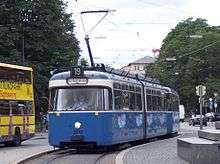
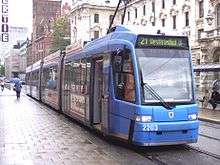
The tram system uses five classes of tram:
- The class P tram is a two-section high-floor articulated motor tram carried on two four-wheeled trucks, usually operating with a similar articulated trailer tram. The trams were built by Rathgeber between 1967 and 1969, and a two-car set carries 315 passengers, with 151 seated. As of 2011, there are only six sets remaining, of which two are reserved for special services. The Class P tram was withdrawn in November 2014 for a short time.[10]
- The class R2 tram is a three-section 100% low-floor articulated motor tram carried on six axles. The trams were built by Adtranz to their GT6N design between 1994 and 1997, and carry 157 passengers, of whom 58 are seated. As of 2011, 68 trams are in service, operating on all lines.[11]
- The class R3 tram is a four-section 100% low-floor articulated motor tram carried on eight axles. The trams were built by Adtranz to their GT8N2 design between 1999 and 2001, and carry 218 passengers, of whom 67 are seated. As of 2011, 20 trams are in service, operating on lines 17, 19, 20, 21, 27, and also 25 on school holidays and weekend.[12]
- The class S tram is a five-section 100% low-floor articulated motor tram carried on eight axles. The trams were built by Stadler to their Variotram design, and carry 221 passengers, of whom 75 are seated. Four trams of this design were delivered in 2009, and a further 10 are on order, with delivery expected in 2011, operating on lines 19, 20, 21 and 22.[13][14][15]
- The class T1 tram is a four-section 100% low-floor articulated motor tram carried on eight axles. The trams were built by Siemens to their Avenio design and carry 220 passengers. Eight trams are on order, and the first was delivered to Munich in November 2012.[16] The first car (or cars) entered service on 17 September 2014 on line 19.[17]
A number of older trams are still owned by the MVG. Some are displayed in the MVG Museum, and may occasionally be seen on special services. Other Munich trams are displayed in the 'Verkehrszentrum' (Transport Centre) of the Deutsches Museum in Munich.
M Tram
In 1950, the modernization of the fleet began with modern open-top cars. In contrast to other companies instead of four-axle Lenkdreiachser chose. The first four drive and two sidecar were delivered in 1950 as a pilot series M 1.62 by Rathgeber. [91] [92] [90] Based on the experience with the M 1, in 1952/53 the improved M 2.63 series with eight engines and sidecar was delivered. The vehicles in this series each had three doors after it came to problems in the pre-series, which had four doors. The entry and exit followed the principle of passenger flow. The last built railcar type M 2 possessed as the first for all other M-railcars "authoritative and formative face" with inclined and rounded windscreen and the above the target plate on the roof patch line number box, leading to the "face" of the Munich tram after the war has been. In 1975, due to the network reduction, the entire M2 / m2 series left service again.
After the Series M2 cars had proved successful both operationally and technically in Munich's post-war traffic, from 1953 the large series M 3.64 / m 3.64 were procured with only slight structural changes. Thus, all old cars of the A and B series could be taken out of service until 1960. From 1963 to 1965, 75 more M / m cars of the modified and improved 5.65 / 5.65 series were delivered. The scissor pantograph was replaced by an one-arm pantograph; In addition, the telescopic sliding doors have been replaced by outward opening swing doors. For the first time, a GEAMATIC controller was fitted as standard. As there were 8 three-wagon trains on the line, consisting of two traction and one sidecar, considerably more traction than side-wagons were procured. This form of operation was abolished in 1972 again, last time drove two railcars (as a double traction) in 1983. In the 1970s, therefore, trailed the M 5.65 series often as two coupled railcars. From 1983, after numerous older M-type M 4.65 railcars were decommissioned and scrapped due to new subway openings, the M 5.65 cars partially operated as a two-car train with an M 4.65 sidecar. The last vehicles of type M drove on 7 December 1998 in the regular service. From Pentecost Saturday to the beginning of October, the M 4.65 / m 4.65 set 2412/3407 is on the road as a Munich-Tram city tour or in Advent as a Christkindl Tram. These were primarily replaced by R series trams.
P Tram
In 1959/1960, it was experimented with two articulated cars of the series P 1.65, which were based on the M-streetcar. Since two conductors were required for them, the trains did not prove themselves and were only in operation until 1975.
In 1963, Rathgeber ordered two prototype trains of a completely new type of short-distance articulated vehicle developed in Bremen, each consisting of one railcar and one sidecar. They were called P 2 in Munich. The prototypes proved their worth, so that between 1967 and 1969 a series of 42 railcars (class P 3.16) and 38 sidecar (type p 3.17) were procured. Because of their high capacity, the P-cars were used on the most heavily loaded lines. In the 1970s and 1980s, the cars ran mainly on the subway feeder lines in the outdoor area. Because of newly built subway routes, the P-cars later migrated back to inner-city lines.
The P / p 2 cars were decommissioned in 1982 (railcar) and 1989 (sidecar). Since the 1990s, after delivery of the successor type R 3.3, the P / p 3 trains are retired. Between 2001 and 2003, many cars were delivered to Romania for use on the tram Timişoara and the tram Bucharest. Other trains were scrapped or given to private interested parties. After temporarily only one car had been used in regular service, six P 3.16 cars and five sidecars were in line use again in mid-2014.
Since lower vehicle requirements were expected after approval of the new Avenio vehicles, MVG issued two motor coaches and one sidecar at the end of 2014 and another one in 2016. At present, three railcars and three sidecars are now operational. Due to renewed series damage on the Vario trains, the P-cars were used from January 2015 on up to three courses on line 28. Currently (as of September 2016), only two courses on the 21/28 line are planned. In the MVG Museum another railcar was preserved as an inoperable exhibit. It was disassembled in the context of spare parts procurement in early 2016.
R Tram
After 1985 had been tested two articulated railcars from Nuremberg (in Munich listed as series N), but had proved to be too small for the passenger volume in Munich, they planned new short-haul cars similar to the series P. But they decided in Munich, to buy three prototypes of a three-piece low-floor car of the GTxN / M / S system from Adtranz as test vehicles. The three cars were delivered 1990/91 and formed the series R 1.1. The cars had two joints and three self-supporting steel car bodies. The trams had cornering and turning loop problems because they were not aligned for that size. The three R 1.1 cars are no longer part of MVG's inventory since they were returned to the manufacturer. Nevertheless, the prototypes proved to be successful, so that a series procurement of the type GT6N, designated in Munich as series R 2.2, was made by MVG. Between 1994 and 1997, a total of 70 three-part low-floor flights were procured. From the outside the R 1.1 similar, many changes were made in the interior. So far, two type R 2.2 trains have been taken out of service after accidents. Towards the end of the 1990s, additional low-floor vehicles with a higher capacity than the R 2.2 series were purchased. After a GT6N from Nuremberg of Adtranz received two reconstructed double joints between the 2nd and 3rd car part, he became the four-part prototype of the GT8N2. The Nuremberg test vehicle was also tested in the Munich tram network and proved itself. In Munich there are 20 trains of the R 3.3. They were delivered between 1999 and 2001. Although the R 3.3 is based directly on the R 2.2, a modified, edged shape was chosen for the front of the vehicle. In addition, it now has six doors and has a more modern look than its predecessor. Since 2010, around 50 R 2.2 trains have been renewed by a subsidiary of Leipziger Verkehrsbetriebe. This should make the tram more spacious, get a higher capacity and wear the colors of the MVG outside.
T Tram
In May 2014, MVG announced a prequalification procedure in which interested manufacturers can submit vehicle designs to the proposals. Due to the increasingly popular and busy trams trams were tendered with double traction, which should be a total of 48 meters long. The trams are to be used on the lines of the trams 20, 21 and 22, which together already form an overloaded two-minute cycle. The double traction trains, which are to consist of two coupled tramways, should provide space for 270 passengers. Double traction was first used on the Munich tram in 1965 with the M5 railcars to offer M / M / m three-car trains on heavily loaded routes. However, for these trains to be able to travel, the stops still need to be extended. The trams should be added to the Munich fleet in 2017 at the earliest. On 6 June 2014, the new type of car for Munich was advertised throughout Europe. In October 2015, MVG finally commissioned 22 more Avenio railcars from Siemens. Nine two-piece and nine three-piece Avenio cars were ordered, which can be coupled with each other. Furthermore, four more four-part trams of the previous type have been ordered. The contract also includes an option for up to 124 other trams. The 22 new trams will be delivered from mid-2017.
Network
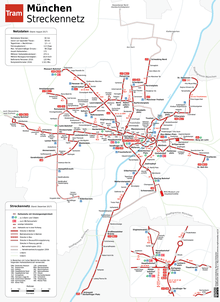
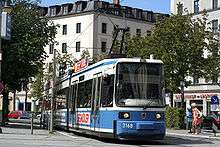
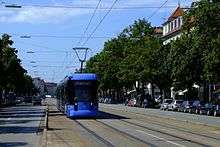
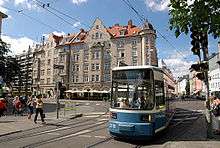
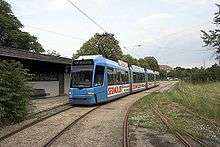
As of 2012, the Munich tram network comprises thirteen daytime routes and four night routes.[2] The tram network totals 79 kilometres (49 mi) of route length,[2] including 55 kilometres (34 mi) of segregated tram lane,[2] with 165 stops.[2][5]
The network is standard gauge track and configured to allow a maximum body width of 2.3 metres (7 ft 7 in). It is electrified using overhead lines at 750 VDC. As all Munich trams are single ended, facilities for turning trams, such as turning loops or wye tracks, are provided at all termini and strategic intermediate points.[2][5][13]
Daytime routes
The daytime route network operates between 04:45 and 01:30, and comprises the following routes:[3]
| Line | Route | Stops | Time |
|---|---|---|---|
| Scheidplatz U 2 U 3 - Hohenzollernplatz U 2 - Leonrodplatz - Rotkreuzplatz U 1 - Romanplatz | 17 | 21 min | |
| Max-Weber-Platz U 4 U 5 - Rosenheimer Platz |
16 | 24 min | |
| Romanplatz – Donnersbergerstraße – Hackerbrücke |
36 | 49 min | |
| Amalienburgstraße – Romanplatz – Donnersbergerstraße – Hackerbrücke |
29 | 35 min | |
| Gondrellplatz – Westendstraße U 4 U 5 – Lautensackstraße – Trappentreustraße – Hauptbahnhof Süd |
32 | 41 min | |
| München-Pasing S 3 S 4 S 6 S 8 S 20 – Pasing Marienplatz – Fürstenrieder Straße – Lautensackstraße – Trappentreustraße - Hauptbahnhof |
36 | 52 min | |
| Moosach S 1 U 3 – Westfriedhof U 1 – Leonrodplatz – Hochschule München –Hauptbahnhof |
16 | 22 min | |
| Westfriedhof U 1 – Leonrodplatz – Hochschule München –Hauptbahnhof |
13 | 17 min | |
| Hochschule München – Hauptbahnhof |
8 | 9 min | |
| Münchner Freiheit U 3 U 6 — Potsdamer Straße — Parzivalplatz — Am Münchner Tor — Anni-Albers-Straße — Domagkstraße — Schwabing Nord | 7 | 8 min | |
| Berg am Laim |
22 | 32 min | |
| Petuelring U 3 – Hohenzollernplatz U 2 – Karolinenplatz – Karlsplatz |
15 | 19 min | |
| Scheidplatz U 2 U 3 – Kurfürstenplatz – Karolinenplatz – Karlsplatz |
12 | 16 min |
Night routes
The night route network operates between 01:30 and 04:30, and comprises the following routes:[18]
| Line | Route |
|---|---|
| Amalienburgstraße – Romanplatz – Donnersbergerstraße – Hackerbrücke | |
| München-Pasing S 3 S 4 S 6 S 8 S 20 – Pasing Marienplatz – Fürstenrieder Straße – Lautensackstraße – Trappentreustraße - Hauptbahnhof | |
| Moosach S 1 U 3 – Westfriedhof U 1 – Leonrodplatz – Hauptbahnhof | |
| Petuelring U 3 - Nordbad - Kurfürstenplatz - Karolinenplatz - Karlsplatz (Stachus) - Sendlinger Tor U 1 U 2 U 3 U 6 - Fraunhoferstraße U 1 U 2 - Mariahilfplatz - Ostfriedhof - Silberhornstraße U 2 - Wettersteinplatz U 1 - Südtiroler Platz - Großhesseloher Brücke |
Future developments
The new 8.7-kilometre (5.4 mi) Tram Westtangente line is being constructed between Romanplatz and Aidenbachstraße U-Bahn station.[5][19][20] The line will stop at three U-Bahn and S-Bahn transfer points: Holzapfelkreuth U-Bahn station, Laimer Platz U-Bahn station, and München-Laim S-Bahn station. The line number for the new route has not yet been designated. It is expected to be completed in 2014.
Munich has expressed an interest in creating a northern tangential line, linking Elizabethplatz and Tivolistaße, thus relieving tramway congestion in the city centre, and reducing the noise caused by buses. As the route would pass through the environmentally-sensitive Englischer Garten, operating the 0.6-kilometre (0.37 mi) section without overhead wiring has been proposed. To this end, the MVG and Stadler equipped one S class tram with experimental lithium-ion batteries, and in May 2011 this tram set the world distance record for such operation by running 16 kilometres (9.9 mi) on a test track at Velten near Berlin. Remaining S class trams, both delivered and on order, are designed to be retro-fitted with similar equipment.[15][21]
There are also plans for the expansion:
After completion of the above-described extension of the line ![]()


- Waldfriedhof-Planegg: Follow the Würmtalstraße like bus line


- Hauptbahnhof-Silberhornstraße: Like bus line

- Südtangente: From the Aidenbachstraße or the Waldfriedhof, the planned Westtangente via Harras, Brudermühlstraße and Candidplatz could be connected with the line



- The line

- From the route to St. Emmeram to one of the S-Bahn stations Englschalking or Johanneskirchen.
- Alte Messe - Nordbad: New route from the Schwanthalerhöhe station via Heimeran- and Schwanthalerstraße to the main station, where the route could be linked to the planning of Hauptbahnhof-Silberhornstraße. The route continues northwards through the Seidl and Schleissheimer Straße to the Gleisdreieck at the Nordbad.
- From the railway station Munich-Moosach to Moosach or from the Westfriedhof to S-Bahn station Untermenzing

- The extension of the tram from St. Emmeram to Unterföhring, because of the nature of the bridge to be used over the Foehringer Ring and the But the road situation in Unterföhring is very unlikely.
- Olympia-Einkaufszentrum - St. Emmeram: New tangent in the north of Munich (like bus line

- Ostbahnhof-Neuperlach: Like bus line

References
- 1 2 http://www.tundria.com/trams/DEU/Munich-2016.shtml
- 1 2 3 4 5 6 7 8 9 10 11 12 13 14 15 16 17 18 19 20 21 22 23 24 "MVG in figures" (PDF). mvg-mobil.de. Münchner Verkehrsgesellschaft mbH (MVG) Marketing. June 2013. Archived from the original (PDF) on 4 October 2013. Retrieved 2 October 2013.
- 1 2 "Tramnetz München" [Munich Tram Network] (PDF) (in German). MVV. 9 December 2012. Archived from the original (PDF) on 4 September 2011. Retrieved 2 October 2013.
- ↑ "MVG: wieder Fahrgastrekord bei U-Bahn, Bus und Tram; Zuwachs in allen Betriebszweigen" [MVG: Passenger record at U-Bahn, bus and tram; growth in all operating sectors] (PDF) (in German). MVG. 27 May 2011. Archived from the original (PDF) on 29 September 2011. Retrieved 7 June 2011.
- 1 2 3 4 5 6 7 8 Pulling, Neil (November 2010). "System Factfile 38: Munich, Germany". Tramways & Urban Transit. Ian Allan Ltd / Light Rail Transit Association. pp. 419–421.
- ↑ "Tram St. Emmeram" (in German). MVG. Archived from the original on 12 May 2012. Retrieved 26 June 2012.
- ↑ "Fahrplanwechsel am 9. Dezember 2012 - MVG auf Wachstumskurs: Angebot wird 2013 um weitere 1,6% gesteigert" [Timetable change on 9 December 2012 - MVG on growth course: Supply is increased 2013 by further 1.6%] (in German). MVG. December 2012. Archived from the original on 4 October 2013. Retrieved 2 October 2013.
- ↑ "Munich opens Pasing tram extension". www.railjournal.com. Simmons-Boardman Publishing Inc. Retrieved 2014-04-10.
- ↑ Vosman, Quintus (13 December 2016). "Munich tram network reaches Berg am Laim". International Railway Journal. Archived from the original on 15 December 2016. Retrieved 15 December 2016.
- ↑ "Tram Typ P" [Tram Type P] (in German). MVG. Retrieved 9 June 2011.
- ↑ "Tram Typ R 2" [Tram Type R 2] (in German). MVG. Retrieved 9 June 2011.
- ↑ "Tram Typ R 3" [Tram Type R 3] (in German). MVG. Retrieved 9 June 2011.
- 1 2 Stadler Rail. "Niederflurstraßenbahn Typ Variobahn für die Stadtwerke München GmbH (SWM)" (PDF) (in German). Retrieved 3 April 2009.
- ↑ "Tram Typ S" [Tram Type S] (in German). MVG. Retrieved 9 June 2011.
- 1 2 "Stadler sets new catenary-free world record". Tramways & Urban Transit. Ian Allan Ltd / Light Rail Transit Association. July 2011. p. 251.
- ↑ "Siemens unveils first Avenio tram in München". Railway Gazette. Retrieved 2014-04-10.
- ↑ "New trams enter service [in München]". Today's Railways Europe (228). Platform 5 Publishing, Ltd. December 2014. p. 15. ISSN 1354-2753.
- ↑ "MVG Nachtlinien" (in German). MVG. Retrieved 2013-10-02.
- ↑ "Tram Pasing" (in German). MVG. Archived from the original on 16 September 2011. Retrieved 17 June 2011.
- ↑ "Tram Westtangente" (in German). MVG. Archived from the original on 29 September 2011. Retrieved 17 June 2011.
- ↑ "Straßenbahn oben ohne – Münchner Tram mit Batterieantrieb schafft Weltrekord" [Munich Tram with Battery drive creates world record] (PDF) (in German). MVG. Archived from the original (PDF) on 29 September 2011. Retrieved 30 June 2011.
- ↑ Article from The Süddeutsche Zeitung of June 27, 2012 to extend the line 25 to the S-Bahn station Berg am Laim
- ↑ .pdf Press release of the MVG of 29 June 2012 on the extension of the line 25 to the S-Bahn station Berg am Laim (PDF file, 323 kB)
External links
| Wikimedia Commons has media related to Tram transport in Munich. |
